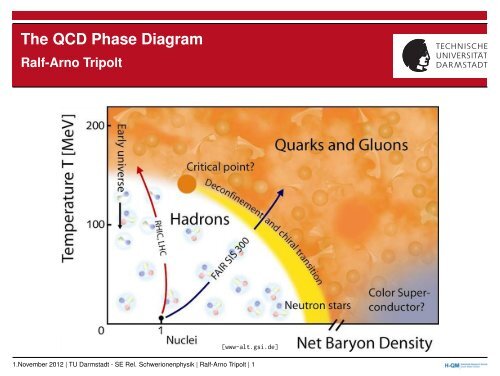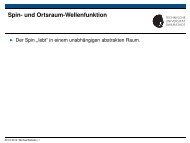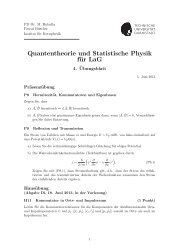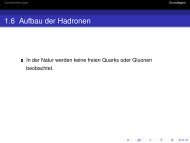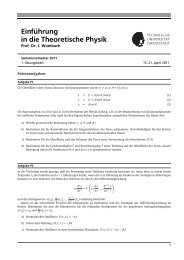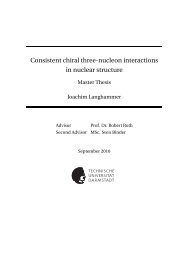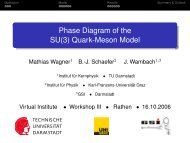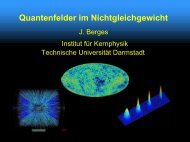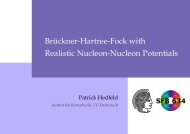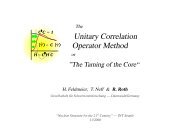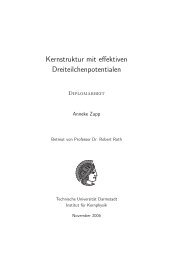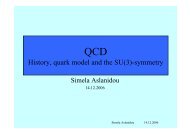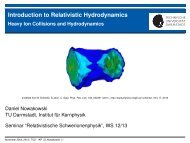The QCD Phase Diagram - Theory Center
The QCD Phase Diagram - Theory Center
The QCD Phase Diagram - Theory Center
You also want an ePaper? Increase the reach of your titles
YUMPU automatically turns print PDFs into web optimized ePapers that Google loves.
<strong>The</strong> <strong>QCD</strong> <strong>Phase</strong> <strong>Diagram</strong><br />
Ralf-Arno Tripolt<br />
[www-alt.gsi.de]<br />
1.November 2012 | TU Darmstadt - SE Rel. Schwerionenphysik | Ralf-Arno Tripolt | 1
Outline<br />
introduction<br />
◮ phases, phase transitions<br />
and thermodynamics<br />
introduction to <strong>QCD</strong><br />
◮ <strong>QCD</strong> basics and symmetries<br />
<strong>QCD</strong> phase diagram from theory<br />
◮ different approaches and results<br />
<strong>QCD</strong> phase diagram from experiment<br />
◮ early universe, neutron stars<br />
and heavy ion collisions<br />
1.November 2012 | TU Darmstadt - SE Rel. Schwerionenphysik | Ralf-Arno Tripolt | 2
What is a <strong>The</strong>rmodynamic <strong>Phase</strong>?<br />
Matter may exist in different phases, throughout which all physical properties,<br />
like density, index of refraction, magnetisation and chemical composition,<br />
are essentially uniform and homogeneous.<br />
homogeneous or inhomogeneous?<br />
[wikipedia.org]<br />
1.November 2012 | TU Darmstadt - SE Rel. Schwerionenphysik | Ralf-Arno Tripolt | 3<br />
...it depends on the scale
More on Inhomogeneous<br />
(Chiral Symmetry Breaking) <strong>Phase</strong>s<br />
Michael Buballa Stefano Carignano Jamil Arif Marco Schramm Daniel Nowakowski<br />
[S. Carignano, D. Nickel, M. Buballa, PRD (2010)]<br />
[S. Carignano, M. Buballa, arXiv:1203.5343]<br />
[M. Buballa, S. Carignano, D. Nickel, Phys.Atom.Nucl. 75 (2012)]<br />
[M. Buballa, S. Carignano, arXiv:1210.7155]<br />
1.November 2012 | TU Darmstadt - SE Rel. Schwerionenphysik | Ralf-Arno Tripolt | 4
<strong>The</strong>rmodynamic Equilibrium<br />
In thermodynamic equilibrium there are no net flows of matter or of energy, no<br />
phase changes, and no unbalanced potentials (or driving forces).<br />
However, a system may not reach this stable equilibrium due to energy barriers -<br />
such a quasi-equilibrium is metastable.<br />
[wikipedia.org]<br />
1.November 2012 | TU Darmstadt - SE Rel. Schwerionenphysik | Ralf-Arno Tripolt | 5
<strong>The</strong> <strong>Phase</strong> <strong>Diagram</strong> of Water<br />
1.November 2012 | TU Darmstadt - SE Rel. Schwerionenphysik | Ralf-Arno Tripolt | 6<br />
[wikipedia.org/wiki/<strong>Phase</strong>_diagram]
Is <strong>The</strong>re a Critical Point?<br />
1.November 2012 | TU Darmstadt - SE Rel. Schwerionenphysik | Ralf-Arno Tripolt | 7
Reminder on <strong>The</strong>rmodynamics<br />
thermodynamic potentials:<br />
energy: E(S, V , N) dE = T dS − P dV + µ dN<br />
free energy: F (T , V , N) = E − TS dF = −S dT − P dV + µ dN<br />
enthalpy: H(S, P, N) = E + PV dH = T dS + V dP + µ dN<br />
free enthalpy: G(T , P, N) = E − TS + PV dG = −S dT + V dP + µ dN<br />
Legendre transformations w.r.t. −µN give further potentials, e.g.:<br />
grand potential: Ω(T , V , µ) = E − TS − µN dΩ = −S dT − P dV − N dµ<br />
some important relations following from this:<br />
◮ µ = ∂G/∂N <br />
T ,P = G/N ◮ Ω = −PV<br />
1.November 2012 | TU Darmstadt - SE Rel. Schwerionenphysik | Ralf-Arno Tripolt | 8
Equilibrium Conditions (I)<br />
second law of thermodynamics (Clausius, 1865):<br />
◮ a closed system with fixed energy E and fixed external parameters (V , N)<br />
tends to maximise its entropy S<br />
it follows that G is minimal for fixed T and P in equilibrium:<br />
S(EA, VA) = SA(EA, VA) + SB(E − EA, V − VA)<br />
= SA + SB(E, V ) − ∂SB(EB, VB)<br />
= const. + SA − EA<br />
T<br />
∂EB<br />
− PVA<br />
T<br />
= const. − GA/T → maximal<br />
1.November 2012 | TU Darmstadt - SE Rel. Schwerionenphysik | Ralf-Arno Tripolt | 9<br />
EA − ∂SB(EB, VB)<br />
VA<br />
∂VB
Equilibrium Conditions (II)<br />
summary of extremal conditions for equilibrium:<br />
V = const. p = const.<br />
S = const. E → min. H → min.<br />
T = const. F, Ω → min. G → min.<br />
[wikipedia.org]<br />
1.November 2012 | TU Darmstadt - SE Rel. Schwerionenphysik | Ralf-Arno Tripolt | 10
Equilibrium Conditions at <strong>Phase</strong> Transitions<br />
consider two phases, vapour (A) and water (B):<br />
E = EA + EB = const.,<br />
V = VA + VB = const.,<br />
N = NA + NB = const.,<br />
the entropy is maximal in equilibrium,<br />
S(EA, VA, NA) = SA + SB → max.<br />
from ∂S/∂EA = 0, ∂S/∂VA = 0 and<br />
∂S/∂NA = 0 it follows that, in equilibrium,<br />
TA = TB, PA = PB, µA = µB [wikipedia.org]<br />
1.November 2012 | TU Darmstadt - SE Rel. Schwerionenphysik | Ralf-Arno Tripolt | 11
<strong>The</strong> Clausius-Clapeyron Equation<br />
consider vapour (A) and water (B) along phase-transition line:<br />
µA(T , P(T )) = µB(T , P(T ))<br />
the total T -derivative gives, with dµ = −s dT + v dP (Duhem-Gibbs),<br />
<br />
∂µA<br />
∂T<br />
<br />
∂µA<br />
+<br />
∂P<br />
dP(T )<br />
dT<br />
=<br />
<br />
∂µB<br />
∂T<br />
<br />
∂µB<br />
+<br />
∂P<br />
dP(T )<br />
dT<br />
P<br />
T<br />
dP(T )<br />
(vA − vB)<br />
dT<br />
= sA − sB,<br />
with s = S/N and v = V /N; for a fixed pressure P we have ∆s = ∆h/T , so<br />
dP(T )<br />
dT<br />
1.November 2012 | TU Darmstadt - SE Rel. Schwerionenphysik | Ralf-Arno Tripolt | 12<br />
= ∆h<br />
T ∆v<br />
P<br />
T
<strong>The</strong> Clausius-Clapeyron Equation for <strong>QCD</strong><br />
to express the Clausius-Clapeyron equation in terms of µ and T , we use the<br />
grand potential Ω(µ, T (µ)), where Ω, S and N are now taken to be divided by V :<br />
ΩA(µ, T (µ)) = ΩB(µ, T (µ)),<br />
taking the total µ-derivative and using dΩ = −SdT − Ndµ gives<br />
<br />
∂ΩA<br />
∂µ<br />
<br />
∂ΩA<br />
+<br />
∂T<br />
dT (µ)<br />
dµ<br />
=<br />
<br />
∂ΩB<br />
∂µ<br />
<br />
∂ΩB<br />
+<br />
∂T<br />
T<br />
µ<br />
dT (µ)<br />
dµ (SA − SB) = −(NA − NB)<br />
dT (µ)<br />
dµ<br />
1.November 2012 | TU Darmstadt - SE Rel. Schwerionenphysik | Ralf-Arno Tripolt | 13<br />
= − ∆N<br />
∆S<br />
T<br />
µ<br />
dT (µ)<br />
dµ
Classification of <strong>Phase</strong> Transitions (I)<br />
order paramter ψ:<br />
is a (macroscopic) quantity that changes characteristically at a phase transition,<br />
e.g. M/M0 for paramagnetic ↔ ferromagnetic or (n − nc)/nc for liquid ↔ gas;<br />
it is zero in one phase (usually above the critical point), and non-zero in the other.<br />
order of phase transitions - modern classification:<br />
◮ ψ changes discontinuously: first-order<br />
◮ ψ changes continuously: second-order<br />
order of phase transitions - Ehrenfest classification:<br />
◮ ∂F/∂y changes discontinuously: first-order<br />
◮ ∂F/∂y is continuous but ∂ 2 F/∂y 2 discontinuous: second-order<br />
1.November 2012 | TU Darmstadt - SE Rel. Schwerionenphysik | Ralf-Arno Tripolt | 14
Classification of <strong>Phase</strong> Transitions (II)<br />
first-order (a) and second-order (b) phase transitions:<br />
[www.chem.queensu.ca]<br />
1.November 2012 | TU Darmstadt - SE Rel. Schwerionenphysik | Ralf-Arno Tripolt | 15
Classification of <strong>Phase</strong> Transitions (III) -<br />
Critical Exponents and Universality<br />
critical exponents describe the behaviour of physical quantities near continuous<br />
(second order) phase transitions and are universal, i.e. they do not depend on the<br />
details of the physical system<br />
most important critical exponents, t = (T − Tc)/Tc > 0:<br />
◮ specific heat: C = −T ∂ 2 F/∂T 2 ∝ t −α<br />
◮ susceptibility: χ = ∂ 2 F/∂J 2 ∝ t −γ ∝ t −ν(2+η)<br />
◮ correlation length: 〈ψ(x)ψ(y)〉 ∼ e −(x−y)/ξ , ξ ∝ t −ν<br />
universality classes:<br />
in general, microscopic theories which have the same global symmetries, have<br />
equal critical exponents and form broad universality classes, e.g. 3D Ising model:<br />
η ≈ 0.04 and ν ≈ 0.63<br />
1.November 2012 | TU Darmstadt - SE Rel. Schwerionenphysik | Ralf-Arno Tripolt | 16
Introduction to <strong>QCD</strong><br />
1.November 2012 | TU Darmstadt - SE Rel. Schwerionenphysik | Ralf-Arno Tripolt | 17
Introduction to <strong>QCD</strong> -<br />
Basics of Quantum Chromodynamics<br />
<strong>QCD</strong> Lagrangian:<br />
L<strong>QCD</strong> = − 1<br />
2 GµνG µν <br />
+<br />
q<br />
¯q iγ µ <br />
Dµ − mq q<br />
with the covariant derivative Dµ = ∂µ − igAµ<br />
and the gluon field strength<br />
G a<br />
a<br />
µν = ∂µAν − ∂νA a<br />
µ + gf abc A b<br />
µ Acν<br />
1.November 2012 | TU Darmstadt - SE Rel. Schwerionenphysik | Ralf-Arno Tripolt | 18<br />
running coupling:<br />
[W.M. Yao, et al., J. Phys. G33, 1 (2006)]
Introduction to <strong>QCD</strong> -<br />
Quark Confinement<br />
lattice <strong>QCD</strong> shows flux tube and linear potential for static quarks:<br />
[G. Bali et al., PRD 51, 5165 (1995), arXiv:9409005]<br />
1.November 2012 | TU Darmstadt - SE Rel. Schwerionenphysik | Ralf-Arno Tripolt | 19<br />
[S. Necco and R. Sommer, NPB 622 (2002), arXiv:0306005]
Introduction to <strong>QCD</strong> -<br />
<strong>Center</strong> Symmetry and Confinement (I)<br />
boundary conditions at finite temperature:<br />
q(t + 1/T ,x) = −q(t,x), Aµ(t + 1/T ,x) = Aµ(t,x)<br />
this constrains the possible gauge transformations g(t + 1/T ,x) = h g(t,x)<br />
gluons respect the Z(SU(3)) center symmetry:<br />
A ′ µ (t + 1/T ,x) = h A′ µ (t,x) h† ⇒ h = z1, z = exp(i2πn/3), n = 1, 2, 3<br />
dynamical quarks break center symmetry:<br />
q ′ (t + 1/T ,x) = g(t + 1/T ,x) q(t + 1/T ,x) = −z g(t,x) q(t,x) = −z q ′ (t,x)<br />
1.November 2012 | TU Darmstadt - SE Rel. Schwerionenphysik | Ralf-Arno Tripolt | 20
Introduction to <strong>QCD</strong> -<br />
<strong>Center</strong> Symmetry and Confinement (II)<br />
thermal quark excitations respecting center symmetry:<br />
thermal quark excitations breaking center symmetry:<br />
[K. Fukushima, Ann. Phys. 304, 72 (2003), hep-ph/0204302]<br />
1.November 2012 | TU Darmstadt - SE Rel. Schwerionenphysik | Ralf-Arno Tripolt | 21
Introduction to <strong>QCD</strong> -<br />
Chiral Symmetry<br />
chiral symmetry SU(Nf )L×SU(Nf )R is conserved for massless quarks:<br />
L = ¯qL(i /D)qL + ¯qR(i /D)qR<br />
+ ¯qLMqR + ¯qRMqL<br />
[T. Schaefer, Lecture on <strong>The</strong> <strong>Phase</strong>s of <strong>QCD</strong>, NC State U.]<br />
symmetry is spontaneously broken, SU(Nf )L×SU(Nf )R →SU(Nf )V :<br />
〈 ¯qLqR + ¯qRqL〉 ≈ −(230 MeV) 3<br />
1.November 2012 | TU Darmstadt - SE Rel. Schwerionenphysik | Ralf-Arno Tripolt | 22
Introduction to <strong>QCD</strong> -<br />
Consequences of the Non-Perturbative Vacuum<br />
dynamical mass generation vs. Higgs mass:<br />
[P. Braun-Munzinger, J. Wambach, arXiv:0801.4256]<br />
1.November 2012 | TU Darmstadt - SE Rel. Schwerionenphysik | Ralf-Arno Tripolt | 23
Introduction to <strong>QCD</strong> -<br />
Summary of <strong>QCD</strong> symmetries<br />
[CBM Physics Book, 2011]<br />
1.November 2012 | TU Darmstadt - SE Rel. Schwerionenphysik | Ralf-Arno Tripolt | 24
<strong>The</strong> <strong>QCD</strong> <strong>Phase</strong> <strong>Diagram</strong> from <strong>The</strong>ory<br />
1.November 2012 | TU Darmstadt - SE Rel. Schwerionenphysik | Ralf-Arno Tripolt | 25
<strong>The</strong> <strong>QCD</strong> <strong>Phase</strong> <strong>Diagram</strong> from <strong>The</strong>ory -<br />
Standard-Lore <strong>Phase</strong> <strong>Diagram</strong><br />
hadron gas:<br />
◮ moderate temperatures and densities<br />
◮ quarks and gluons are confined<br />
◮ chiral symmetry is spontaneously broken<br />
quark-gluon plasma:<br />
◮ very high temperatures and densities<br />
◮ deconfined quarks and gluons<br />
◮ chiral symmetry is restored<br />
color superconductor:<br />
◮ T < 100 MeV and very high densities<br />
◮ quarks form bosonic pairs in analogy to BCS theory<br />
1.November 2012 | TU Darmstadt - SE Rel. Schwerionenphysik | Ralf-Arno Tripolt | 26<br />
[CBM physics book (2011)]
<strong>The</strong> <strong>QCD</strong> <strong>Phase</strong> <strong>Diagram</strong> from <strong>The</strong>ory -<br />
Overview of <strong>The</strong>oretical Approaches<br />
[CBM Physics Book, 2011]<br />
1.November 2012 | TU Darmstadt - SE Rel. Schwerionenphysik | Ralf-Arno Tripolt | 27
<strong>The</strong> <strong>QCD</strong> <strong>Phase</strong> <strong>Diagram</strong> from <strong>The</strong>ory -<br />
Models (I) - MIT Bag Model<br />
Bag Model (Chodos et al., 1974):<br />
◮ simple implementation of<br />
confinement<br />
◮ weakly interacting quarks are<br />
confined to a speherical cavity with<br />
≈ 1 fm<br />
radius R ∼ Λ −1<br />
<strong>QCD</strong><br />
◮ cost in energy density for creating<br />
the cavity is the bag constant B<br />
◮ for a free gas of massless quarks<br />
and gluons,<br />
pQGP = 37 π2<br />
90 T 4 + µ 2<br />
qT 2 + µ4q − B<br />
2<br />
2π<br />
1.November 2012 | TU Darmstadt - SE Rel. Schwerionenphysik | Ralf-Arno Tripolt | 28<br />
[hyperphysics.phy-astr.gsu.edu]<br />
[M. Buballa, Phys. Rept. 407, 205 (2005)]
<strong>The</strong> <strong>QCD</strong> <strong>Phase</strong> <strong>Diagram</strong> from <strong>The</strong>ory -<br />
Models (II) - NJL and QM Models<br />
NJL model<br />
(Nambu and Jona-Lasinio, 1961):<br />
LNJL = ¯q(iγ µ ∂µ−mq)q+G ( ¯qq) 2 + ( ¯qiγ5τq) 2<br />
quark-meson model:<br />
LQM = ¯q(iγ µ ∂µ − h(σ + iγ5τπ))q<br />
+ 1<br />
2 (∂µσ) 2 + 1<br />
2 (∂µπ) 2 − U(σ, π)<br />
1.November 2012 | TU Darmstadt - SE Rel. Schwerionenphysik | Ralf-Arno Tripolt | 29<br />
M [MeV]<br />
300<br />
400<br />
300<br />
200<br />
100<br />
0<br />
0<br />
T [MeV] 100<br />
200<br />
200<br />
T MeV<br />
200<br />
150<br />
100<br />
50<br />
µ [MeV]<br />
0<br />
400<br />
[courtesy S. Möller]<br />
100 200 300<br />
[RAT]<br />
0<br />
Μ MeV
<strong>The</strong> <strong>QCD</strong> <strong>Phase</strong> <strong>Diagram</strong> from <strong>The</strong>ory -<br />
Models (III) - Color Superconducting <strong>Phase</strong>s<br />
consider quark matter at T = 0 and large density nq:<br />
◮ quarks near the Fermi surface interact only weakly<br />
◮ attractive single-gluon exchange channel leads to formation of Cooper pairs<br />
◮ 2SC: only quarks of two colors (e.g. red and green) participate in pairing<br />
◮ CFL: all colors and flavors pair with each other<br />
[M.Alford, A.Schmitt, Rev.Mod.Phys.80 (2008)]<br />
1.November 2012 | TU Darmstadt - SE Rel. Schwerionenphysik | Ralf-Arno Tripolt | 30
<strong>The</strong> <strong>QCD</strong> <strong>Phase</strong> <strong>Diagram</strong> from <strong>The</strong>ory -<br />
Perturbative <strong>QCD</strong> and Chiral Perurbation <strong>The</strong>ory<br />
Perturbative <strong>QCD</strong>:<br />
◮ expansion in αs for high energies an<br />
◮ quarks and gluons are relevant<br />
degrees of freedom<br />
Chiral Perurbation <strong>The</strong>ory:<br />
◮ expansion in terms of energies and<br />
(Goldstone boson) masses for low<br />
momenta<br />
◮ stable (light) hadrons are relevant<br />
degrees of freedom<br />
1.November 2012 | TU Darmstadt - SE Rel. Schwerionenphysik | Ralf-Arno Tripolt | 31<br />
[A. Vuorinen, Phys.Rev. D68, 054017 (2003)]<br />
[P. Gerber, H. Leutwyler, Nucl. Phys. B321, 387 (1989)]
<strong>The</strong> <strong>QCD</strong> <strong>Phase</strong> <strong>Diagram</strong> from <strong>The</strong>ory -<br />
Lattice <strong>QCD</strong><br />
→ talk by D. Scheffler on Lattice <strong>QCD</strong>, 15.11.2012<br />
◮ full <strong>QCD</strong> is solved from first principles on<br />
a discrete Euclidean space-time grid<br />
◮ predicts a cross-over from hadronic<br />
matter to QGP for µq = 0<br />
at Tc ≈ 170 MeV<br />
◮ confinement and chiral transition seem<br />
to appear at exactly the same<br />
temperature for µq = 0<br />
problems:<br />
◮ most lattice calculations still use<br />
unrealistically large light-quark masses<br />
◮ fermion-sign problem at finite µq<br />
1.November 2012 | TU Darmstadt - SE Rel. Schwerionenphysik | Ralf-Arno Tripolt | 32<br />
[F.Karsch, E.Laermann, arXiv:0305025]
<strong>The</strong> <strong>QCD</strong> <strong>Phase</strong> <strong>Diagram</strong> from <strong>The</strong>ory -<br />
Summary<br />
→ talk by S. Finkbeiner on Fluctuations and the <strong>QCD</strong> phase boundary - theory, 6.12.2012<br />
what to expect:<br />
◮ bag model predicts that Tc decreases<br />
with increasing µq<br />
◮ models (e.g. NJL, QM) predict first-order<br />
transition for low T and large µq<br />
◮ lattice results indicate cross over<br />
at small µq<br />
◮ together, this implies the existence<br />
of a critical endpoint<br />
1.November 2012 | TU Darmstadt - SE Rel. Schwerionenphysik | Ralf-Arno Tripolt | 33<br />
[CBM physics book (2011)]
<strong>The</strong> <strong>QCD</strong> <strong>Phase</strong> <strong>Diagram</strong> from <strong>The</strong>ory -<br />
Summary<br />
what to expect:<br />
◮ bag model predicts that Tc decreases<br />
with increasing µq<br />
◮ models (e.g. NJL, QM) predict first-order<br />
transition for low T and large µq<br />
◮ lattice results indicate cross over<br />
at small µq<br />
◮ together, this implies the existence<br />
of a critical endpoint<br />
1.November 2012 | TU Darmstadt - SE Rel. Schwerionenphysik | Ralf-Arno Tripolt | 34<br />
what we really know:<br />
[M.Nahrgang, M.Bleicher, arXiv:1111.3771]
<strong>The</strong> <strong>QCD</strong> <strong>Phase</strong> <strong>Diagram</strong> from Experiment<br />
1.November 2012 | TU Darmstadt - SE Rel. Schwerionenphysik | Ralf-Arno Tripolt | 35
<strong>The</strong> <strong>QCD</strong> <strong>Phase</strong> <strong>Diagram</strong> from Experiment -<br />
Overview<br />
[T. Schaefer, Lecture on <strong>The</strong> <strong>Phase</strong>s of <strong>QCD</strong>, NC State U.]<br />
1.November 2012 | TU Darmstadt - SE Rel. Schwerionenphysik | Ralf-Arno Tripolt | 36
<strong>The</strong> <strong>QCD</strong> <strong>Phase</strong> <strong>Diagram</strong> from Experiment -<br />
Early Universe<br />
1.November 2012 | TU Darmstadt - SE Rel. Schwerionenphysik | Ralf-Arno Tripolt | 37
<strong>The</strong> <strong>QCD</strong> <strong>Phase</strong> <strong>Diagram</strong> from Experiment -<br />
Neutron Stars<br />
◮ density around five<br />
times nuclear<br />
saturation density<br />
◮ temperature<br />
reaches a few keV<br />
◮ possibility to study<br />
strongly interacting<br />
matter under<br />
extreme conditions<br />
not available in the<br />
laboratory<br />
1.November 2012 | TU Darmstadt - SE Rel. Schwerionenphysik | Ralf-Arno Tripolt | 38<br />
[CBM physics book (2011)]
<strong>The</strong> <strong>QCD</strong> <strong>Phase</strong> <strong>Diagram</strong> from Experiment -<br />
Heavy Ion Collisions (I)<br />
→ talk by D. Nowakowski on Hydrodynamics - theory, 22.11.2012<br />
stages of a heavy-ion collision:<br />
◮ color glass condensate: dense, weakly-interacting, contracted gluon-walls<br />
◮ glasma: immediately after the collision, chromo E and B fields have only<br />
longitudinal components forming flux tubes along the collision axis<br />
◮ sQGP: strongly coupled QGP, not a perturbatively describable plasma<br />
◮ chemical freeze-out: inelastic collisions stop, composition of hadrons is fixed<br />
◮ thermal freeze-out: interaction rates insufficient for thermal equilibrium<br />
1.November 2012 | TU Darmstadt - SE Rel. Schwerionenphysik | Ralf-Arno Tripolt | 39<br />
[L. McLerran, HPT Workshop (2012)]
<strong>The</strong> <strong>QCD</strong> <strong>Phase</strong> <strong>Diagram</strong> from Experiment -<br />
Heavy Ion Collisions (II)<br />
→ talk by NN on Collective flow at RHIC and LHC - experimental data, 29.11.2012<br />
evidence for quark gluon plasma:<br />
◮ the Fourier coefficient<br />
v2 = 〈cos(2Φ)〉 of the distribution of<br />
the momenta of produced particles<br />
can be compared to predictions from<br />
hydrodynamical calculations<br />
◮ close agreement implies that the<br />
quark-gluon matter produced at<br />
RHIC flows collectively like a liquid<br />
with negligible η/s,<br />
i.e. is a strongly coupled QGP<br />
[P. Braun-Munzinger, J. Wambach, arXiv:0801.4256]<br />
[J. Adams, et al. (STAR), Phys. Rev. C72, 014904 (2005)]<br />
[P. Huovinen et al., Phys. Lett. B503, 58 (2001)]<br />
1.November 2012 | TU Darmstadt - SE Rel. Schwerionenphysik | Ralf-Arno Tripolt | 40
<strong>The</strong> <strong>QCD</strong> <strong>Phase</strong> <strong>Diagram</strong> from Experiment -<br />
Heavy Ion Collisions (III)<br />
→ talk by G. Dentinger on <strong>The</strong>rmal fits of hadron yields and the <strong>QCD</strong> phase diagram, 8.11.2012<br />
evidence for a phase transition:<br />
◮ information about the location of the<br />
freeze-out point is obtained by<br />
measuring the ratios of particle<br />
yields, and fitting to a statistical<br />
model with T and µB as parameters<br />
◮ at least for small µB the extracted<br />
temperature is closely linked to the<br />
(calculated) phase boundary<br />
[P. Braun-Munzinger, J. Wambach, arXiv:0801.4256]<br />
1.November 2012 | TU Darmstadt - SE Rel. Schwerionenphysik | Ralf-Arno Tripolt | 41
<strong>The</strong> <strong>QCD</strong> <strong>Phase</strong> <strong>Diagram</strong> from Experiment -<br />
Heavy Ion Collisions (IV)<br />
→ talk by P. Piasecki on Search for the <strong>QCD</strong> phase boundary with experiments, 13.12.2012<br />
approaching the critical endpoint:<br />
◮ in the approximation of ideal hydrodynamics, entropy is conserved and the<br />
expanding fireball follows a trajectory of constant baryon per entropy ratio n/s<br />
◮ T increases at phase transition since latent heat is released and the lower<br />
number of dof’s in the hadronic phase would result in a smaller entropy<br />
[M. Stephanov, arXiv:0402115 (2006)], [M. Stephanov, K. Rajagopal and E. Shuryak, arXiv:9806219]<br />
1.November 2012 | TU Darmstadt - SE Rel. Schwerionenphysik | Ralf-Arno Tripolt | 42
Summary -<br />
Contemporary View of the <strong>QCD</strong> <strong>Phase</strong> <strong>Diagram</strong><br />
[J. Wambach, K. Heckmann and M. Buballa, arXiv: 1111.5475]<br />
1.November 2012 | TU Darmstadt - SE Rel. Schwerionenphysik | Ralf-Arno Tripolt | 43
Appendix<br />
1.November 2012 | TU Darmstadt - SE Rel. Schwerionenphysik | Ralf-Arno Tripolt | 44


